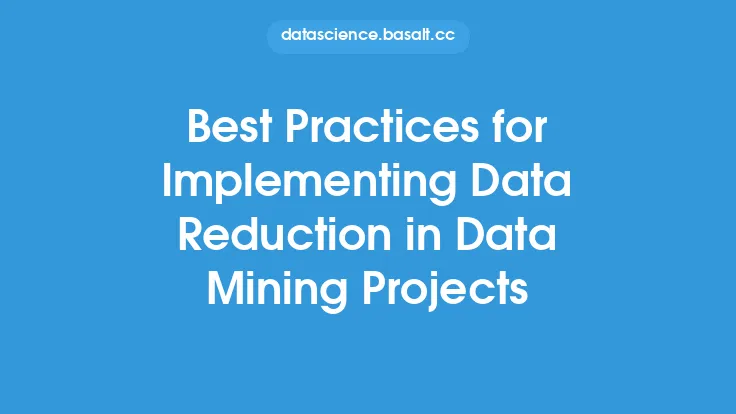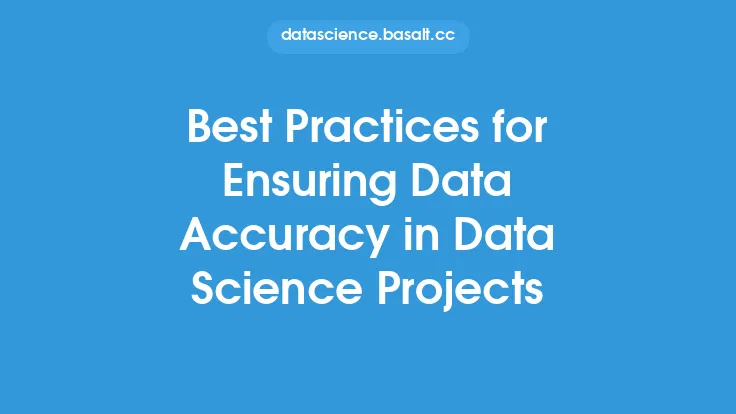Implementing pattern discovery in data mining projects requires a strategic approach to ensure that the insights gained are accurate, reliable, and actionable. Pattern discovery is a crucial step in the data mining process, as it enables organizations to identify hidden relationships, trends, and patterns in their data. To get the most out of pattern discovery, it's essential to follow best practices that cover data preparation, algorithm selection, model evaluation, and deployment.
Data Preparation
Data preparation is a critical step in pattern discovery, as it directly affects the quality of the insights gained. The first step in data preparation is to collect and integrate data from various sources. This may involve merging data from different databases, files, or external sources. Once the data is collected, it's essential to clean and preprocess it to remove any errors, inconsistencies, or missing values. Data cleaning may involve handling missing values, removing duplicates, and transforming data into a suitable format for analysis.
Data transformation is another critical step in data preparation. This may involve converting data types, aggregating data, or creating new features. For example, in a customer purchase analysis, data transformation may involve converting date fields into a suitable format for analysis or creating new features such as purchase frequency or average order value. Data transformation requires a deep understanding of the data and the problem being addressed.
Algorithm Selection
Choosing the right algorithm for pattern discovery is crucial, as different algorithms are suited for different types of data and problems. There are several types of pattern discovery algorithms, including decision trees, clustering, association rule mining, and neural networks. Decision trees are suitable for classification problems, while clustering is suitable for segmentation problems. Association rule mining is suitable for identifying relationships between variables, while neural networks are suitable for complex pattern recognition tasks.
When selecting an algorithm, it's essential to consider the type of data, the problem being addressed, and the computational resources available. For example, decision trees are suitable for small to medium-sized datasets, while neural networks require large datasets and significant computational resources. It's also essential to evaluate the performance of different algorithms and choose the one that provides the best results.
Model Evaluation
Evaluating the performance of pattern discovery models is critical to ensure that the insights gained are accurate and reliable. There are several metrics for evaluating pattern discovery models, including accuracy, precision, recall, and F1 score. Accuracy measures the proportion of correct predictions, while precision measures the proportion of true positives among all positive predictions. Recall measures the proportion of true positives among all actual positive instances, while F1 score measures the harmonic mean of precision and recall.
In addition to these metrics, it's essential to evaluate the model's performance using techniques such as cross-validation and bootstrapping. Cross-validation involves splitting the data into training and testing sets and evaluating the model's performance on the testing set. Bootstrapping involves creating multiple samples of the data and evaluating the model's performance on each sample. These techniques help to ensure that the model's performance is not due to chance and that it generalizes well to new data.
Deployment and Maintenance
Deploying and maintaining pattern discovery models require careful planning and execution. Once a model is developed and evaluated, it's essential to deploy it in a production environment where it can be used to make predictions or recommendations. This may involve integrating the model with other systems, such as databases or web applications.
Maintaining pattern discovery models is also critical, as the data and the problem being addressed may change over time. This may involve retraining the model on new data, updating the algorithm or parameters, or even replacing the model with a new one. It's essential to monitor the model's performance over time and make adjustments as needed to ensure that it remains accurate and reliable.
Handling Imbalanced Data
Imbalanced data is a common problem in pattern discovery, where one class has a significantly larger number of instances than the other classes. This can lead to biased models that perform well on the majority class but poorly on the minority class. To handle imbalanced data, it's essential to use techniques such as oversampling the minority class, undersampling the majority class, or using class weights.
Oversampling the minority class involves creating additional instances of the minority class to balance the data. Undersampling the majority class involves reducing the number of instances of the majority class to balance the data. Class weights involve assigning different weights to each class to give more importance to the minority class. These techniques can help to improve the model's performance on the minority class and reduce bias.
Handling High-Dimensional Data
High-dimensional data is another common problem in pattern discovery, where the number of features is very large. This can lead to the curse of dimensionality, where the model's performance degrades as the number of features increases. To handle high-dimensional data, it's essential to use techniques such as feature selection or dimensionality reduction.
Feature selection involves selecting a subset of the most relevant features to reduce the dimensionality of the data. Dimensionality reduction involves transforming the data into a lower-dimensional space using techniques such as principal component analysis (PCA) or singular value decomposition (SVD). These techniques can help to improve the model's performance and reduce the risk of overfitting.
Conclusion
Implementing pattern discovery in data mining projects requires a strategic approach that covers data preparation, algorithm selection, model evaluation, and deployment. By following best practices and using techniques such as data transformation, algorithm selection, and model evaluation, organizations can gain accurate and reliable insights from their data. Additionally, handling imbalanced data and high-dimensional data requires special attention to ensure that the model's performance is not degraded. By using techniques such as oversampling, undersampling, class weights, feature selection, and dimensionality reduction, organizations can improve the model's performance and gain valuable insights from their data.





